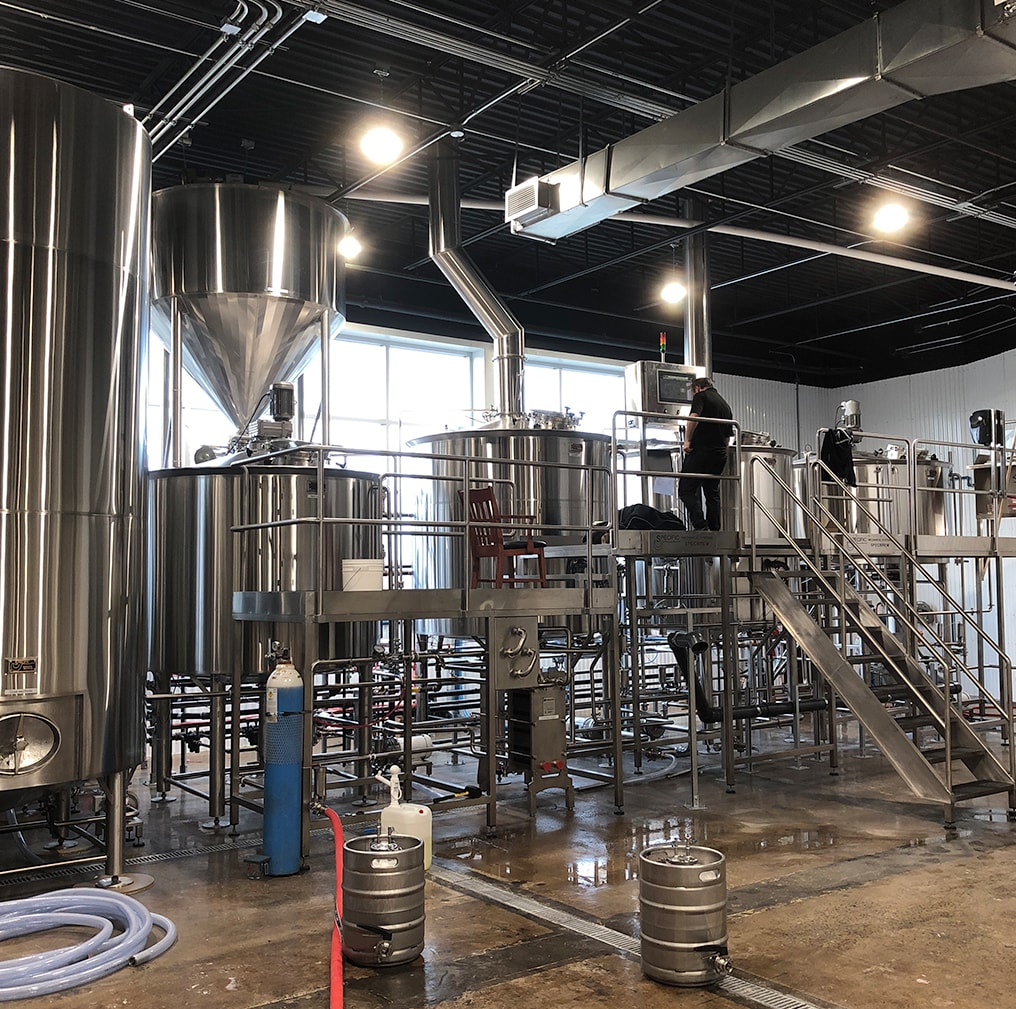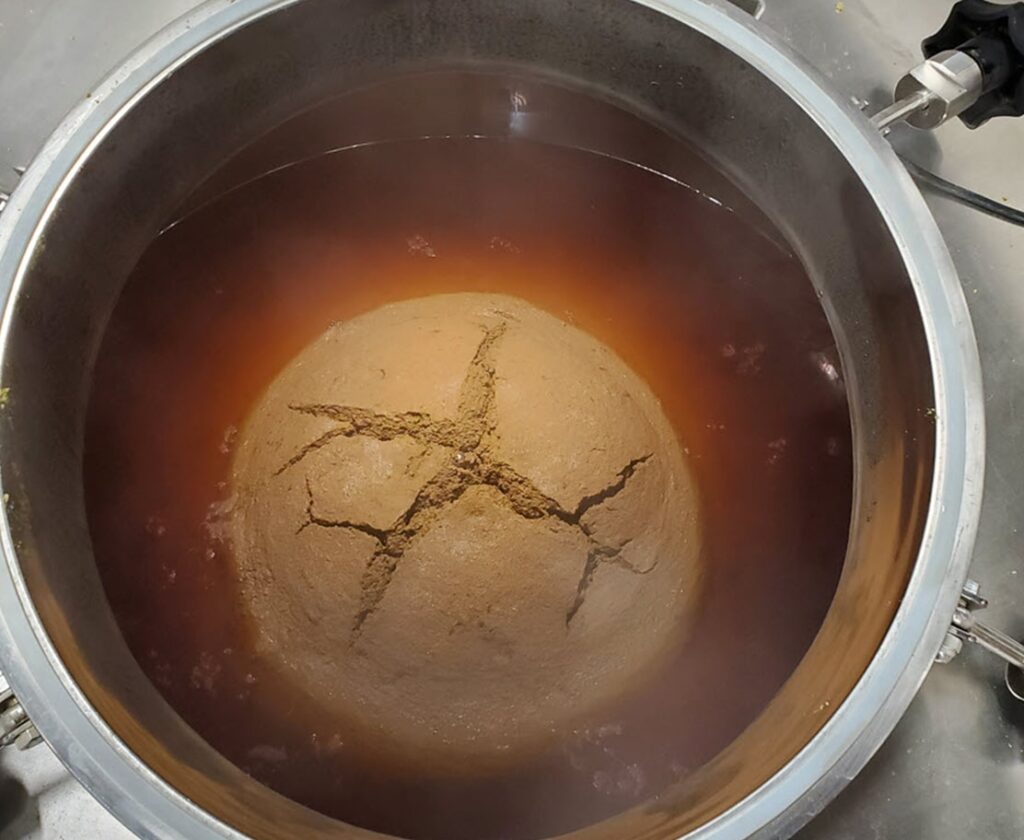Process
Designed For Brewers & Maximum Output.
Specific Mechanical provides complete brewing systems for brewpubs, microbreweries and production breweries. Follow the numbered links below in the infographic to learn more about how our systems relate to the brewing process.
Legend
Hover over numbers to expand tooltips.
Standard
A two-roll or four-roll mill cracks the malted barley to the desired coarseness.
SpecBrew Automation
SpecBrew provides full grain handling capability for conveyance of malt from an outdoor silo and can integrate the use of super sacks to provide complete automation of each malt style required for any recipe. The throughput rate of the malt mill is matched to the speed of the flex auger to smoothly convey your grist to the hopper.
Standard
The hopper holds the entire recipe of cracked malt (grist) required for your brew. When the brewer is ready to mash-in, hydration water is activated and the slide gate is opened.
SpecBrew Automation
SpecBrew automation includes control of an actuated knife gate valve attached to the hopper discharge, and also controls water mixing (liquor blending) and flow rate for mash-in.
Standard
Holds and heats brewing process water for mash-in and sparge. This tank is also used to collect the exit water from the heat exchanger after each knock out. Heating options for the hot liquor tank include a steam jacket, an external brazed plate heat exchanger, or internal electric immersion elements.
SpecBrew Automation
Using dedicated liquor pumps, SpecBrew monitors and controls hot liquor temperature, re-circulation, and distribution.
Standard
The mash tun is a heated vessel and incorporates the use of mixing blades to homogeneously mix heated mash-in water from the hot liquor tank with grist during the mash-in process. If step infusion mashing is required, the steam jackets on the vessel provide the ability to increase the mash temperature. Mashing is the term used for the hot water steeping process which hydrates the barley, activates the malt enzymes, and converts the grain starches into fermentable sugars.
SpecBrew Automation
SpecBrew monitors and controls the process of mashing-in by maintaining the desired grist to liquor ratio, as well as ensuring strike temperatures are in accordance with your recipe. It also regulates the temperature of your mash by controlling the vessel steam jackets and mixing blades within the vessel. Automated step mashing is built into SpecBrew functionality.
Standard
A lauter tun is used to separate the extracted wort from the grain by using a false bottom screen. The screen is designed with small slits and holds the bed of grain while allowing the liquid to flow through. The grain bed acts as a filter and holds back small solids, allowing the wort to be collected under the false bottom. As the wort is collected under the screen, it begins to “run-off” and is transferred to the brewkettle.Some small breweries use a combination mash/lauter tun, in which the mashing process and lautering process are performed in the same vessel.
SpecBrew Automation
SpecBrew automates the function of the retractable rakes, sparge water flow, temperature and the vorlauf function. Pressure sensors in the vessel monitor the differential pressure across the false bottom screens. The run-off pump speed is controlled to maintain the correct differential pressure to avoid a “stuck mash”. The spent grain plow automatically empties the lauter tun into the desired equipment installed for spent grain removal. Your system can also be fitted with sensors to monitor turbidity, pH and plato/specific gravity to provide further information and finer control over this process.
Standard
The brewhouse vessels incorporate the use of dedicated pumps to transfer product from one vessel to another. Optional brewhouse designs can offer a diverter panel arrangement or hard piped individual valves.
SpecBrew Automation
SpecBrew manages the entire transfer process during a brew while monitoring flow rates between vessels.
Standard
The brewkettle is where the wort is boiled to a desired specific gravity. Hops are typically added at various stages throughout the boil to add flavor, aroma and bitterness to the wort. Brewkettle heating options include steam jackets or an internal or external calandria.
SpecBrew Automation
SpecBrew controls the time and temperature within the brewkettle to accurately hit the desired specific gravity.
Standard
After boiling the wort, it is transferred to the whirlpool where the wort is circulated to clarify by separating soluble proteins (trub), which collect in the center of the vessel. The clear wort is then pumped through the heat exchanger and into the fermenter.
SpecBrew Automation
After boiling the wort in the brewkettle, the wort is automatically transferred to the whirlpool where it is circulated to separate soluble proteins (trub) which collect in the center of the vessel. The clear wort is then automatically pumped through the heat exchanger and into the chosen fermenter. SpecBrew tracks and logs which batch is in each fermenter.
Standard
The heat exchanger rapidly cools the wort to the appropriate fermentation temperature, typically between 10°C (52°F) to 17°C (62.5°F). The heat exchanger uses either cold water (liquor) from a Cold Liquor Tank (CLT) or city water and/or cold glycol as cooling mediums. The cooled wort is then transferred to the fermenter.
SpecBrew Automation
SpecBrew monitors and controls the flow rate of the wort and the cold liquor through the heat exchanger to achieve the desired knockout temperature.SpecBrew can incorporate the use of a Hop Back vessel. Based on the selected recipe, the hop back will automatically be enabled for that brew, or bypassed entirely.
Standard
The cooled wort is pumped into the fermenter where yeast is added (pitched). Primary fermentation typically occurs for 3 to 7 days. The fermenter can be used as an aging tank, or the beer can be transferred (racked) to a separate conditioning vessel for the aging period (typically 10 to 20 days).
SpecBrew Automation
SpecBrew automatically monitors and controls the temperature within the fermenter based on set points entered by the brewer.
During fermentation, hops may be added to add further character to the beer. To facilitate this process, a hop cannon can be used to inject the hops into the fermenter via a hop port on the top of the tank. Using a hop cannon avoids the use of a ladder by the brewer and offers a safe way to add hops to the fermenter.
Carbon dioxide (CO2) is added to the beer through a carbonating stone to adjust the carbonation levels to the brewer’s preference. The beer is then packaged from the bright tank via kegs, bottles, or cans, or plumbed directly to your tap handles.
Standard
A two-roll or four-roll mill cracks the malted barley to the desired coarseness.
SpecBrew Automation
SpecBrew provides full grain handling capability for conveyance of malt from an outdoor silo and can integrate the use of super sacks to provide complete automation of each malt style required for any recipe. The throughput rate of the malt mill is matched to the speed of the flex auger to smoothly convey your grist to the hopper.
Standard
The hopper holds the entire recipe of cracked malt (grist) required for your brew. When the brewer is ready to mash-in, hydration water is activated and the slide gate is opened.
SpecBrew Automation
SpecBrew automation includes control of an actuated knife gate valve attached to the hopper discharge, and also controls water mixing (liquor blending) and flow rate for mash-in.
Standard
Holds and heats brewing process water for mash-in and sparge. This tank is also used to collect the exit water from the heat exchanger after each knock out. Heating options for the hot liquor tank include a steam jacket, an external brazed plate heat exchanger, or internal electric immersion elements.
SpecBrew Automation
Using dedicated liquor pumps, SpecBrew monitors and controls hot liquor temperature, re-circulation, and distribution.
Standard
The mash tun is a heated vessel and incorporates the use of mixing blades to homogeneously mix heated mash-in water from the hot liquor tank with grist during the mash-in process. If step infusion mashing is required, the steam jackets on the vessel provide the ability to increase the mash temperature. Mashing is the term used for the hot water steeping process which hydrates the barley, activates the malt enzymes, and converts the grain starches into fermentable sugars.
SpecBrew Automation
SpecBrew monitors and controls the process of mashing-in by maintaining the desired grist to liquor ratio, as well as ensuring strike temperatures are in accordance with your recipe. It also regulates the temperature of your mash by controlling the vessel steam jackets and mixing blades within the vessel. Automated step mashing is built into SpecBrew functionality.
Standard
A lauter tun is used to separate the extracted wort from the grain by using a false bottom screen. The screen is designed with small slits and holds the bed of grain while allowing the liquid to flow through. The grain bed acts as a filter and holds back small solids, allowing the wort to be collected under the false bottom. As the wort is collected under the screen, it begins to “run-off” and is transferred to the brewkettle.Some small breweries use a combination mash/lauter tun, in which the mashing process and lautering process are performed in the same vessel.
SpecBrew Automation
SpecBrew automates the function of the retractable rakes, sparge water flow, temperature and the vorlauf function. Pressure sensors in the vessel monitor the differential pressure across the false bottom screens. The run-off pump speed is controlled to maintain the correct differential pressure to avoid a “stuck mash”. The spent grain plow automatically empties the lauter tun into the desired equipment installed for spent grain removal. Your system can also be fitted with sensors to monitor turbidity, pH and plato/specific gravity to provide further information and finer control over this process.
Standard
The brewhouse vessels incorporate the use of dedicated pumps to transfer product from one vessel to another. Optional brewhouse designs can offer a diverter panel arrangement or hard piped individual valves.
SpecBrew Automation
SpecBrew manages the entire transfer process during a brew while monitoring flow rates between vessels.
Standard
The brewkettle is where the wort is boiled to a desired specific gravity. Hops are typically added at various stages throughout the boil to add flavor, aroma and bitterness to the wort. Brewkettle heating options include steam jackets or an internal or external calandria.
SpecBrew Automation
SpecBrew controls the time and temperature within the brewkettle to accurately hit the desired specific gravity.
Standard
After boiling the wort, it is transferred to the whirlpool where the wort is circulated to clarify by separating soluble proteins (trub), which collect in the center of the vessel. The clear wort is then pumped through the heat exchanger and into the fermenter.
SpecBrew Automation
After boiling the wort in the brewkettle, the wort is automatically transferred to the whirlpool where it is circulated to separate soluble proteins (trub) which collect in the center of the vessel. The clear wort is then automatically pumped through the heat exchanger and into the chosen fermenter. SpecBrew tracks and logs which batch is in each fermenter.
Standard
The heat exchanger rapidly cools the wort to the appropriate fermentation temperature, typically between 10°C (52°F) to 17°C (62.5°F). The heat exchanger uses either cold water (liquor) from a Cold Liquor Tank (CLT) or city water and/or cold glycol as cooling mediums. The cooled wort is then transferred to the fermenter.
SpecBrew Automation
SpecBrew monitors and controls the flow rate of the wort and the cold liquor through the heat exchanger to achieve the desired knockout temperature.SpecBrew can incorporate the use of a Hop Back vessel. Based on the selected recipe, the hop back will automatically be enabled for that brew, or bypassed entirely.
Standard
The cooled wort is pumped into the fermenter where yeast is added (pitched). Primary fermentation typically occurs for 3 to 7 days. The fermenter can be used as an aging tank, or the beer can be transferred (racked) to a separate conditioning vessel for the aging period (typically 10 to 20 days).
SpecBrew Automation
SpecBrew automatically monitors and controls the temperature within the fermenter based on set points entered by the brewer.
During fermentation, hops may be added to add further character to the beer. To facilitate this process, a hop cannon can be used to inject the hops into the fermenter via a hop port on the top of the tank. Using a hop cannon avoids the use of a ladder by the brewer and offers a safe way to add hops to the fermenter.
Carbon dioxide (CO2) is added to the beer through a carbonating stone to adjust the carbonation levels to the brewer’s preference. The beer is then packaged from the bright tank via kegs, bottles, or cans, or plumbed directly to your tap handles.

Brewery System Sizing
Breweries come in many different shapes and sizes. Let us help you select the proper system based on the production requirements for your brewery and business model.

Building Requirements
Your dream is becoming a reality and you’re ready to design and build your brewery. Here are a few important design considerations to accommodate your brewery system.

